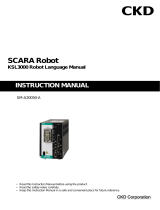
Table of Contents
5.3 Anatomy of a Vision Object ..................................................................76
5.3.1 The Search Window ................................................................76
5.3.2 The Model Window..................................................................78
5.3.3 The Model Origin.....................................................................80
5.4 Using Vision Objects ............................................................................81
5.4.1 ImageOp Object ....................................................................81
5.4.2 Geometric Object ..................................................................86
5.4.3 Correlation Object ...............................................................108
5.4.4 Blob Object..........................................................................132
5.4.5 Edge Object.........................................................................146
5.4.6 Polar Object.........................................................................151
5.4.7 Frame Object.......................................................................162
5.4.8 Line Object ..........................................................................167
5.4.9 Point Object.........................................................................173
5.4.10 Working with Multiple Results from a Single Object ............181
5.4.11 Turning All Vision Object Labels On and Off........................187
5.4.12 Turning All Vision Object Graphics On.................................187
6. Histograms and Statistics Tools 188
6.1 Vision Guide Histograms..................................................................188
6.1.1 Using Histograms ..................................................................188
6.1.2 Example Histograms .............................................................188
6.1.3 Histograms with Correlation Objects .....................................189
6.1.4 Histograms with Blob Objects................................................190
6.2 Using Vision Guide Statistics............................................................193
6.2.1 Dialog Box Options/ Info........................................................193
6.2.2 Vision Objects and Statistics Supported ................................194
6.2.3 Vision Object Results Supported ...........................................195
6.2.4 Vision Object Statistics Available From SPEL+ .....................196
7. Vision Sequence 198
7.1 Vision Sequence Overview ................................................................198
7.2 Vision Sequence Definition & General Information ............................199
7.3 The Vision Sequence Tab ..................................................................200
7.4 Vision Sequence Properties and Results ...........................................202
7.5 Creating a New Vision Sequence.......................................................204
7.6 Deleting a Vision Sequence ...............................................................205
7.7 Deleting a Vision Object.....................................................................206
7.8 Change Order of Sequence Steps .....................................................206
7.9 Running Vision Sequences ................................................................207
Vision Guide 5.0 Rev.5 ix






















